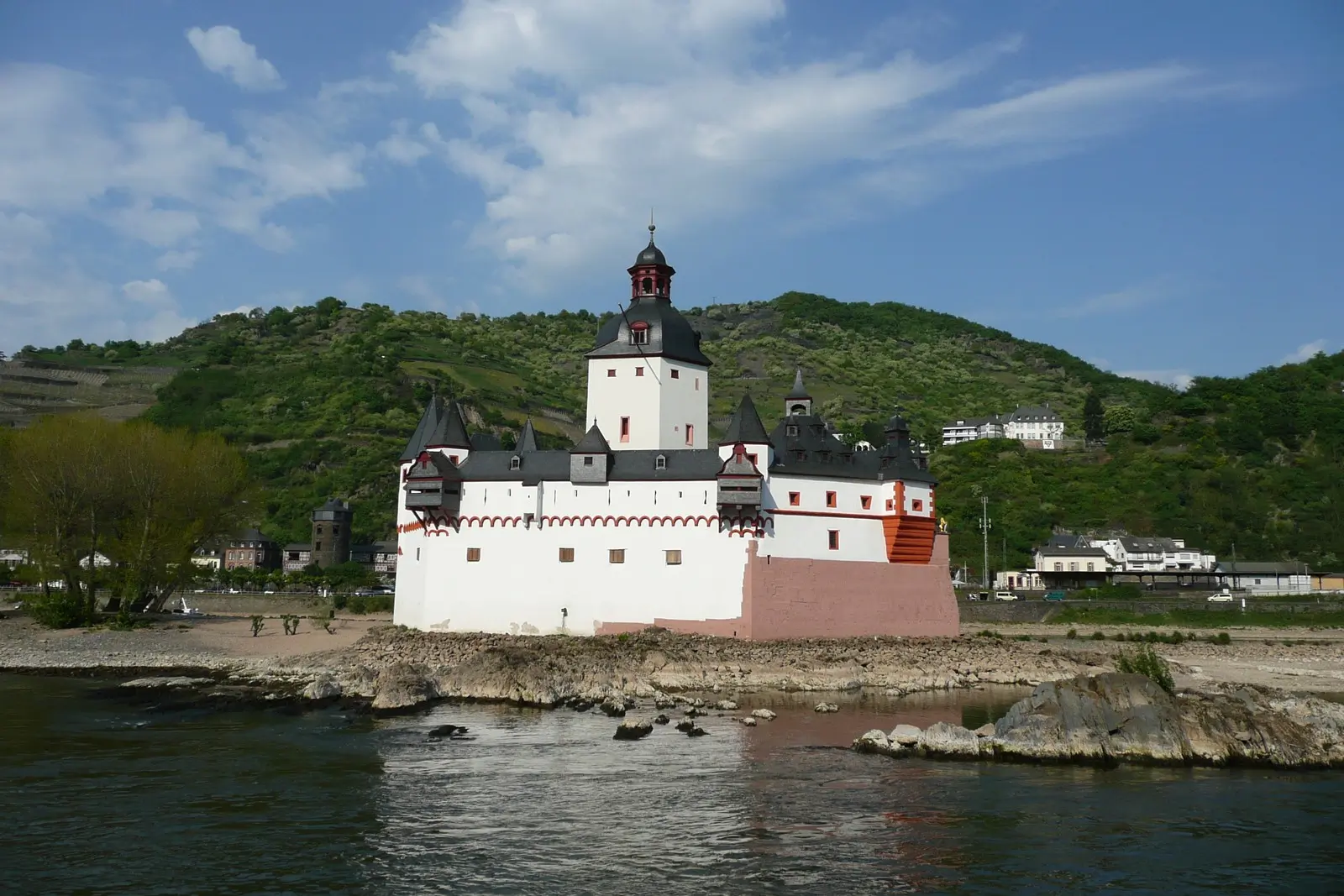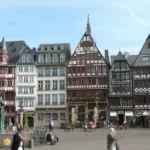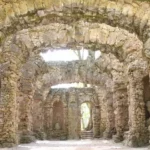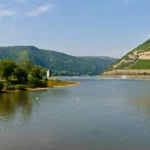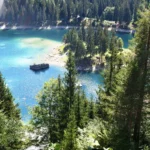Last Updated on 17/01/2024
We continue the story of the Rhine castles. In this part, we will explore the central and most picturesque part of the Rhine valley from Kaub to Koblenz, where the Lorelei rock is located. Here the banks of the Rhine become higher, and each castle has its own romantic history.
Castles on the Middle Rhine on the map. 1. From Rüdesheim to Bacharach
Rhine valley boat tours, public transport and welcome cards
Moselle: Castle Eltz, Cochem and Trier attractions
Attractions around Frankfurt am Main, along the Rhine to Koblenz
Technik museum Speyer
Castle Road (Burgenstrasse). 1. Neckar cycle route Mannheim – Eberbach
What to see in Heidelberg
Local public transport in Germany
90+ parks and gardens in Germany on the map
Rhine castles from Kaub to Sankt Goar
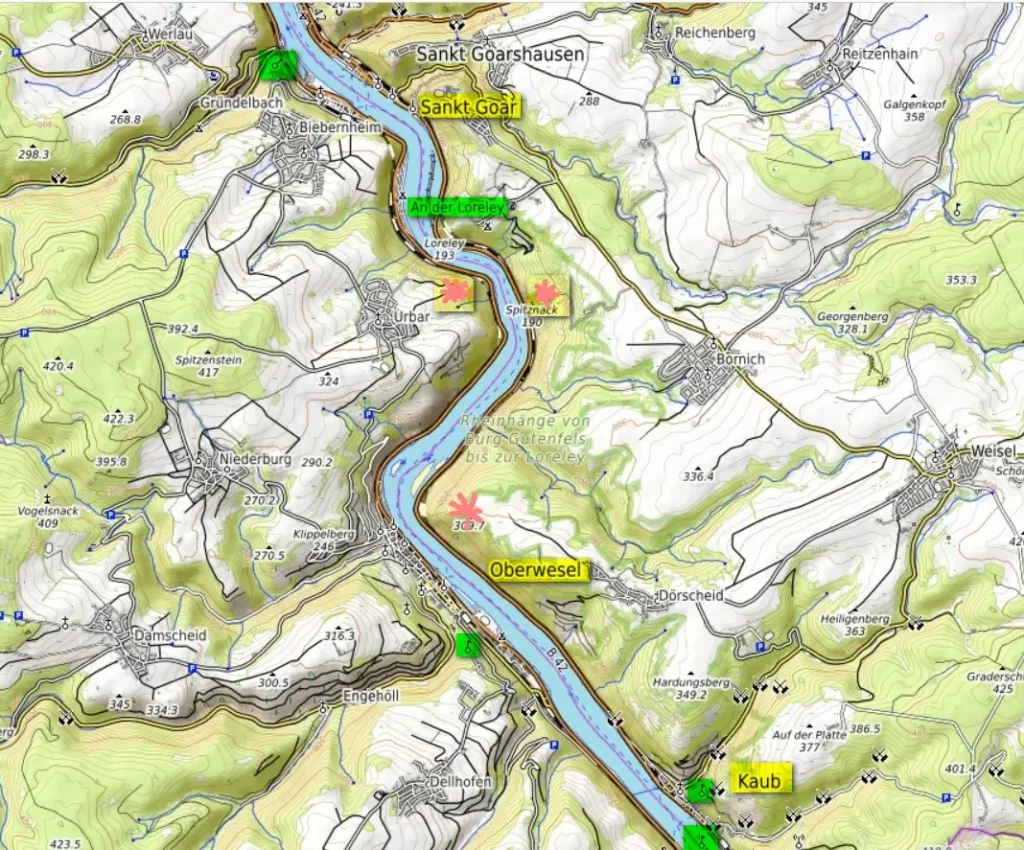
Kaub
The next two castles are near Kaub (right bank, ferry).
At Kaub, the Prussian and Russian troops under the leadership of Blücher pursued the French in 1814 and crossed the Rhine. Therefore, in the center stands a statue of Blücher.
But the main attraction, of course, is not this statue, but the small Pfalzgrafenstein castle, which is often called simply the Pfalz, located on an island in the middle of the river. Link
This customs station was built in 1327. Duke Ludwig of Bavaria (who was also a count of the Palatinate) in 1277 bought Kaub, Gutenfels castle with it and customs rights. And then his son built a fortress on the island.
He did not want to share with the church, he preferred to collect everything in his treasury. With it the church was decidedly dissatisfied. But, apart from threats, the church could not oppose anything serious.
The place was chosen extremely well. The castle was never taken or destroyed. It was almost impossible to escape the customs officers, and for those who disagreed, a chain was raised from the bottom of the river. The castle can be viewed by taking the ferry.
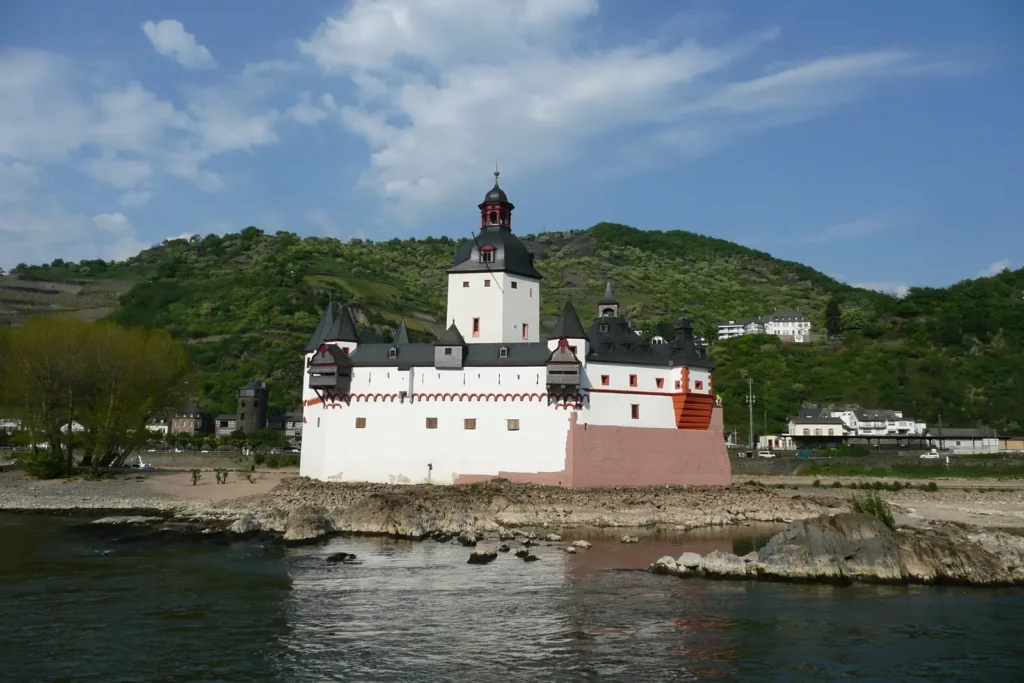
Gutenfels castle
Above Kaub – Gutenfels castle (Burg Gutenfels).
The Kaub fortress was built at the beginning of the 13th century. At the end of the 13th century it was bought together with the city by Wittelsbach, who received the Palatinate. After one unsuccessful siege, it was renamed Gutenfels (“good (strong) rock”).
During the 30 Years’ War, the fortress changed hands several times. The French destroyed it, but (which is atypical) not in 1689, but under Napoleon. It seems to be for the fact that he was not met with a proper salute. In the 19th century was restored. It has been preserved as one of the best examples of castle building from the Hohenstaufen period (12-13 centuries).
A few years ago the castle was sold and turned into a hotel.

Oberwesel
The next stop on our way is Oberwesel. As in Bacharach, city fortifications (12-13 centuries) have been preserved here.
Other attractions include:
Schonburg Castle,
the Gothic Church of Our Lady (14th century),
the Church of St. Martin also 14th c.
and the ruins of a 13th-century Minorite monastery.
The name of the city comes from the Celtic language. Under the Romans, there was a station for changing horses. Under the Frankish kings – royal possessions, which later passed to the bishop of Magdeburg. In 1220 the city was given the rights of a free city. But already in 1309, it passed into the submission of the Archbishop of Trier and remained there until the secularization of 1802.
Schönburg Caslte (Burg Schönburg) was built in the first half of the 12th century. From the 14th century it belonged together with the city to the Archbishop of Trier.
In 1689 it was destroyed, at the beginning of the 19th century partially restored. In the 20th century it became a youth hostel, a hotel and a restaurant.

Sankt Goar
Sankt-Goar as a city located in the middle of the Lorelei Valley, not far from the Lorelei rock, is more known than other towns. In addition, there are a ferry connecting the town with Sankt-Goarhausen and Rheinfels castle (Burg Rheinfels). Once it was the largest and most powerful fortress in these parts.
In St. Goarhausen, on the other side, there is also a castle – Katz (Cat) Castle (Burg Katz). And downstream you can see another one – Maus Castle.
The city center is very small, literally one street and side streets with it between the railway and highway B9. The old town has not picturesque or antiquity of houses. Although a couple of towers from the city fortifications have been preserved (curiously, people live in them).
There was already a settlement on the site of Sankt Goar in Roman times and, obviously, a crossing, since the Roman road continues on the other side. In the 6th c. a young monk Goar came from Aquitaine. He settled in a cave, engaged in missionary activities, gave shelter to travelers along the river and the needy. After his death, pilgrims began to come here, a chapel was built, and the city gradually grew.
From the 8th c. the place belonged to the monastery of Prüm, not far from Trier. Vogts of the monastery (governors, whose fief became hereditary from the 12th century) von Katzenelnbogen received from the 12th century title of counts. In 1245, the counts built the castle of Reinfels in Sankt Goar.
The name of the Katzenelnbogens is associated with the beginning of the history of Riesling wine. In the 15th century, with the termination of the male line, the possessions of the Katzenelnbogens on the Rhine passed to the Landgraviate of Hesse.
Rheinfels Castle
Catacombs and underground passages attract many to Rheinfels Castle. It is recommended that you bring a flashlight with you when visiting. Link
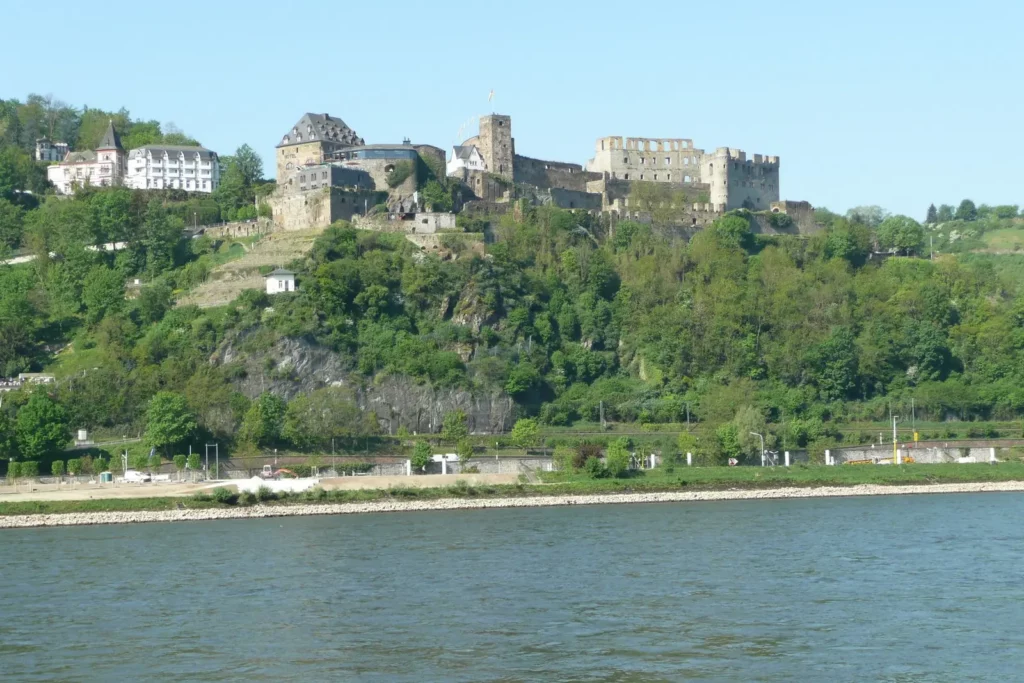
The castle performed customs functions. In 1479 it passed to the Landgraves of Hesse, who built themselves a palace in the Renaissance style. In 1692, the fortress managed to resist the French, but in 1794 it surrendered to them without a fight and was destroyed.
Prince Wilhelm of Prussia, later Emperor Wilhelm 1, used the ruins as a source of material for the restoration of the Ehrenbreitstein fortress in Koblenz.
Lorelei Rock
Of course, now we are no longer able to feel what the sailors felt many centuries ago, when the fast waters of the Rhine carried them between the stones right to this rock, and opposite the waterfall rang (dry out in the 19th century), loud voices gave birth to an echo, and no one knew if he would make it to the next town.
Having safely passed the rock or with difficulty getting ashore after a shipwreck, the shocked boatmen listened with pleasure and retold the story about the bad nymphs of the Rhine in one of the many variants over a glass of wine. But in those days, the story was not yet a well-formed legend, and Lorelei meant only “whispering rock.”

When the German romantics arrived for the “scene”, echoes of the old times still lived here. The romantic atmosphere was not spoiled by steamboats with a loudspeaker telling a story in several languages, nor by cars, nor by countless barges and freight trains, nor by a huge parking lot of trailers opposite the rock.
Romantics artistically designed and advertised story (there are poetic, visual and musical ads – for every taste), for which the locals are very grateful to them – this is one of the most visited places on the Rhine. The plot was best described by Heine.
It makes no sense to climb the rock itself, tourists have long trampled down the place – parking, restaurant, visitor center, etc., etc. – unless you are going to ride the Lorelei-Bob. Link
How to get to Lorelei rock: bus 595 from Sankt Goarhausen to the observation deck
But the observation decks overlooking the Lorelei rock are worth the climb.
Viewpoint opposite the rock – point Maria Ruh near the village of Urbar.
Another lookout point with a view of the rock through Katz Castle is from the village of Patersberg (walking up from Sankt Goarhausen or bus 582).
An excellent view is also from the Felsenkanzel lookout point (Bornich village).
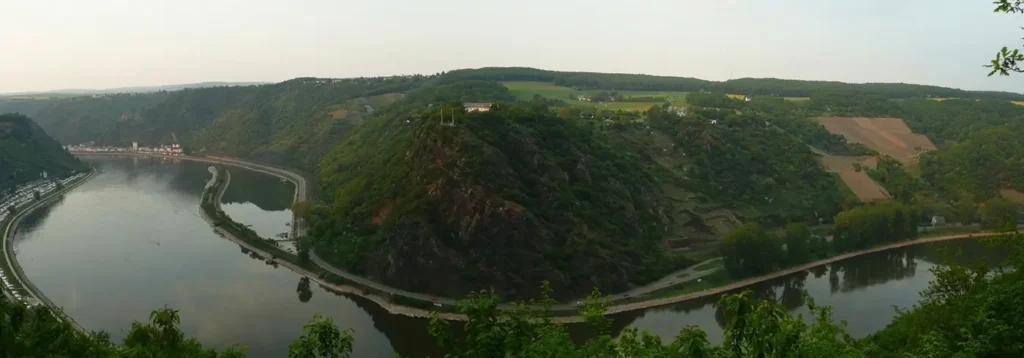
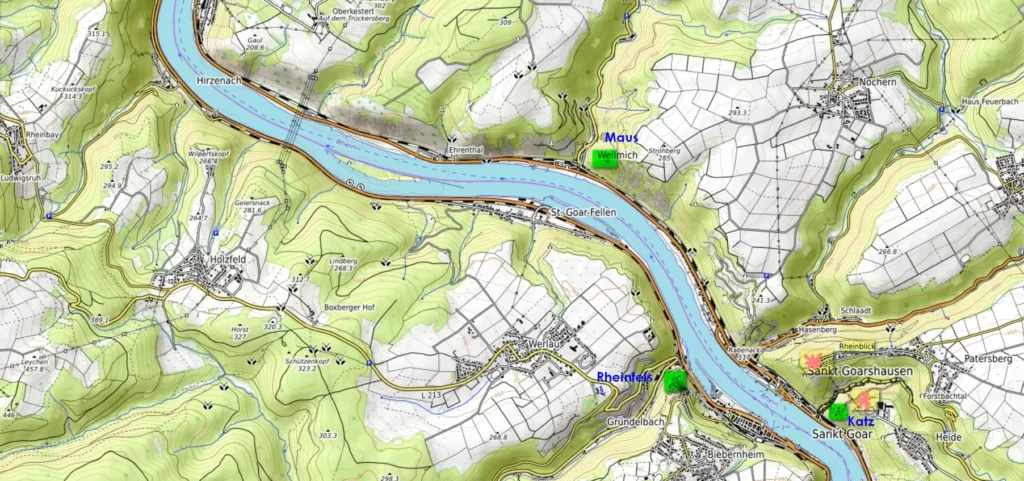
Katz Castle (Burg Katz)
Katz Castle is privately owned and closed to the public.
Katz Castle was originally called Neukatzelnbogen, but the name was shortened to Katz. It was built around 1360 and served as additional protection for the Rheinfels castle. In 1806, the castle was destroyed by order of Napoleon, at the end of the 19th century rebuilt. Now it is in private ownership.

Castle Maus
The castle on the right side above the small village of Welmich belonging to Sankt Goarhausen was originally to be called Peterseck. It was built by the archbishop of Trier in opposition to the castles of Rheinfels and Katz in 1356.
According to legend, the name Maus (Mouse) was given by counts who often said that their Cat (Katz) would eat this little Mouse (Maus). In the 14th – early 15th century the castle served as the residence of the archbishop. The castle was not destroyed, but fell into disrepair and turned into ruins, then it was partially restored.
The castle hosts concerts and weddings. There used to be also shows with birds of prey, but not now. Link

Rhine castles from Sankt Goar to Boppard
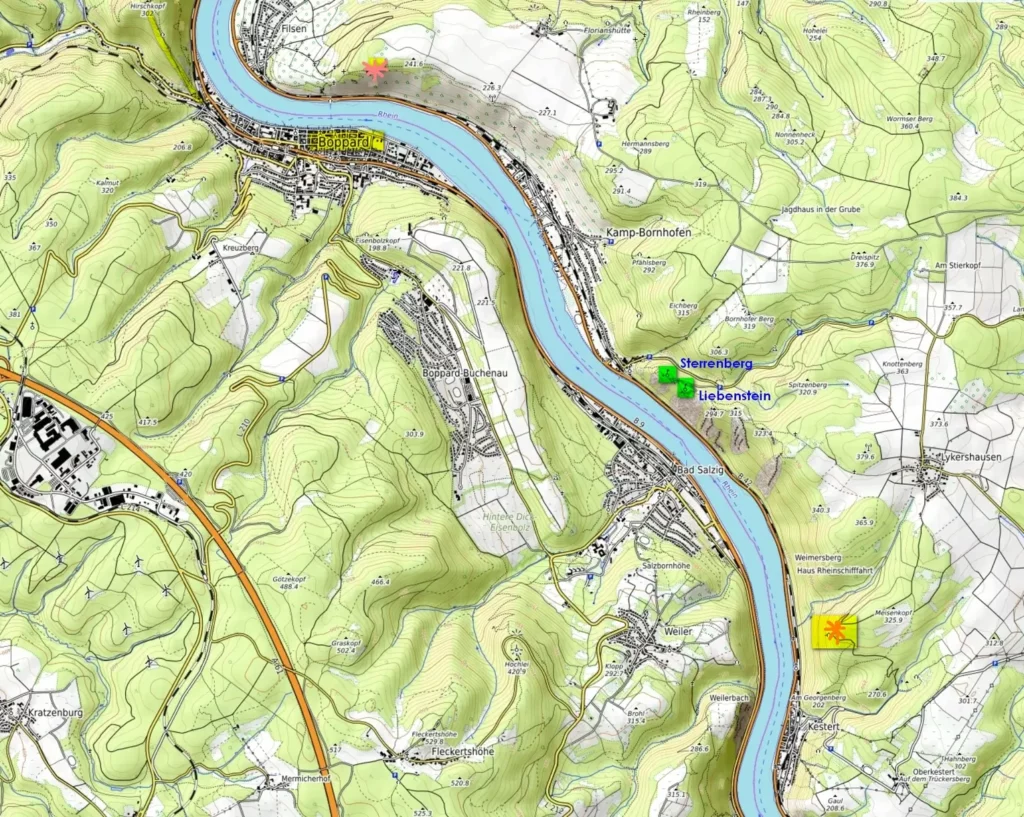
Castle Liebenstein and Castle Sterrenberg
Further along the right bank appear “Warring Brothers”. The name comes from the legend, which exists in numerous versions, about two brothers who quarreled over a girl. But it has nothing to do with real history.
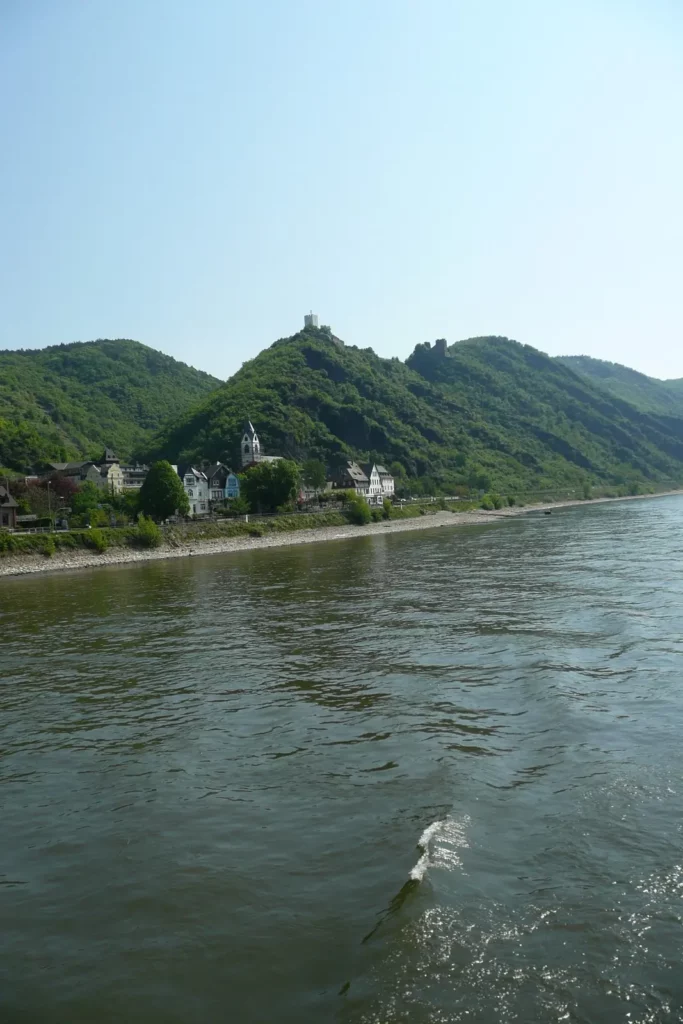
The first is Burg Liebenstein (also Levenstein), the second – Burg Sterrenberg. Below the town of Kamp-Bornhofen.
Sterrenberg is now home to the Academy of Old Music and the Museum of Instruments. Link
Liebenstein Castle is privately owned (hotel and restaurant).
The first to be built was the Castle Sterrenberg (first mentioned in 1034 and considered the oldest surviving on the Rhine). The first of the famous owners who received the castle in fief was the Bolandin family. From the 13th century the castle had different owners until it passed completely to the archbishop of Trier.
Archbishop in the middle of the 14th century decided to build a wall between the castles. From the end of the 16th century the castle became uninhabited. Restoration and conservation work was carried out in the 70s of the last century.
Liebenstein was built in the 13th century, for what reason is not clear. It was first mentioned in connection with the sale to the knights Stromberg and Sterrenberg, who began to call themselves from this period von Liebenstein. From the end of the 16th century the castle became uninhabited.

Boppard
Boppard (left bank) – a large settlement, a resort town. After Boppard, the Rhine forms its only loop, which can be seen with the local chair-lift.
Attractions in Boppard:
chair-lift Link
partially preserved walls of the Roman camp (reaching 9 m high, the best preserved Roman walls in Germany),
partially preserved city medieval walls and towers,
church of st. Severus on the Market Square (1236, Romanesque style), built on the foundations of Roman baths,
customs castle of the archbishop of Trier (city museum). Link
The name Boppard comes from the Celtic language. In the 4th c. there was an important Roman camp here. In the Middle Ages, the city was in the royal domain and was a free imperial city until 1309, when the king gave it to his brother, the Archbishop of Trier. The townspeople categorically did not like this and several times they tried to fight, and the archbishop used force.
In the 19th century healing baths were opened and the city turned into a resort.
From Boppard to Koblenz

Marksburg Castle and Braubach
After Boppard, the banks become less interesting – flatter and more populated, and all attention is focused on the Marksburg castle seen from afar. Marksburg is the undisputed leader of attendance. Link
The castle was built in the 12th century, and it changed its owners many times. In the 15th century it passed to the landgraves of Hesse, who carried out reconstruction in accordance with the requirements of the time, built batteries and bastions for cannons, thanks to which the castle survived the 30-year war. By the 19th century it fell into neglect, served as a prison.
In 1900, the castle was bought and restored by the German Castle Society, whose headquarters are still located in the castle. When planning a visit to the castle, do not forget that it is located on the right side.
The town of Braubach has been mentioned in documents since the 7th century. Old half-timbered houses of the 16th-18th centuries have been preserved here. In addition to Marksburg Castle, there is also a 16th-century castle Philippsburg (also owned by the German Castle Society).
Half timbered houses in Germany through history


Lahnstein
The next town, also on the right side, is Lahnstein. This is a large town, practically joined with Koblenz. Here the river Lahn, which in itself deserves a separate excursion, flows into the Rhine. The town consists of two parts – Oberlahnstein and Niederlahnstein, separated until 1969 and having a different history.
Main attractions:
Lahneck castle (Burg Lahneck). The castle is privately owned, but it is allowed on a guided tour. Link
old town hall,
Martinsburg Palace (Oberlanstein).

Settlements on the site of the city have existed since the Stone Age. The Romans built a lookout tower (Niederlahnstein) and limes, the remains of which are still preserved in the local forests. In the Carolingian Empire, two cities belonged to different provinces.
Lahneck Castle was built in 1226 by the Archbishop of Mainz to protect his estate and the silver mine. In 1298, King Adolf of Nassau stayed at the castle before the battle with Albrecht 1 of Habsburg. In that battle, the king was killed. Count Friedrich Schilling von Lahnstein participated in a conspiracy against Albrecht, as a result of which Albrecht was killed in 1308. In 1309, the castle was captured, and Friedrich Schilling was executed. According to legend, in 1312 the last 12 knights-templars defended themselves in the castle, however, they write the same about Ehrenfels castle. During the 30-year war, the castle was badly damaged and turned into ruins.
In addition to the romantic legend about the templars, there is also a completely unromantic and sad story of a 17-year-old Scottish girl who came with her parents to the Rhine in the middle of the 19th century. She climbed into the castle tower, and the steps behind her collapsed. No one guessed where to look for her, and only a year later, when restoration work began, the remains were found along with the diary that she kept before her death.
Rhens
Opposite Lahnstein, on the left bank of the Rhine, are the town of Rhens and a little further on the castle of Stolzenfels (Burg Stolzenfels).
Rhens is a very quiet town with preserved city walls, half-timbered houses. In the Middle Ages, for some reason, the Electors of the Rhine chose it to hold their “G4” (archbishops of Mainz, Trier, Cologne, Elector of the Palatinate). This happened for the first time in 1273 to discuss the candidacy of Rudolf Habsburg.
In 1308, Frankfurt am Main was appointed the official place for choosing a new emperor, but at the same time, Charles IV made a stone royal throne (Königstuhl) in Rhens. For its construction, the inhabitants of the city received customs privileges. Since this time, emperors have risen to the throne several times, although they were elected elsewhere. The modern building belongs to the 19th century, since the previous one was destroyed, and is located in a different place.
Stolzenfels castle
By 2011, Stolzenfels Castle (Link) had been completely renovated to attract tourists visiting the garden exhibition in Koblenz. We were just there that year and we got the impression that all the money was spent not on flowers, but on a castle and a cable car.

The castle was built in the 13th century by Archbishop of Trier to protect the customs station, destroyed in 1689.
In 1815, the city of Koblenz donated the ruins to the crown prince, the future king Friedrich Wilhelm 4. The castle was restored in a romantic style as a summer residence. This is what makes it interesting – as an example of the romantic style on the Rhine.
Koblenz
Koblenz is a large city. Here the Moselle flows into the Rhine, here are also the first bridges over the Rhine after Mainz. During World War II, the city was heavily bombed, and if you don’t have time to see it, you won’t be missing much.
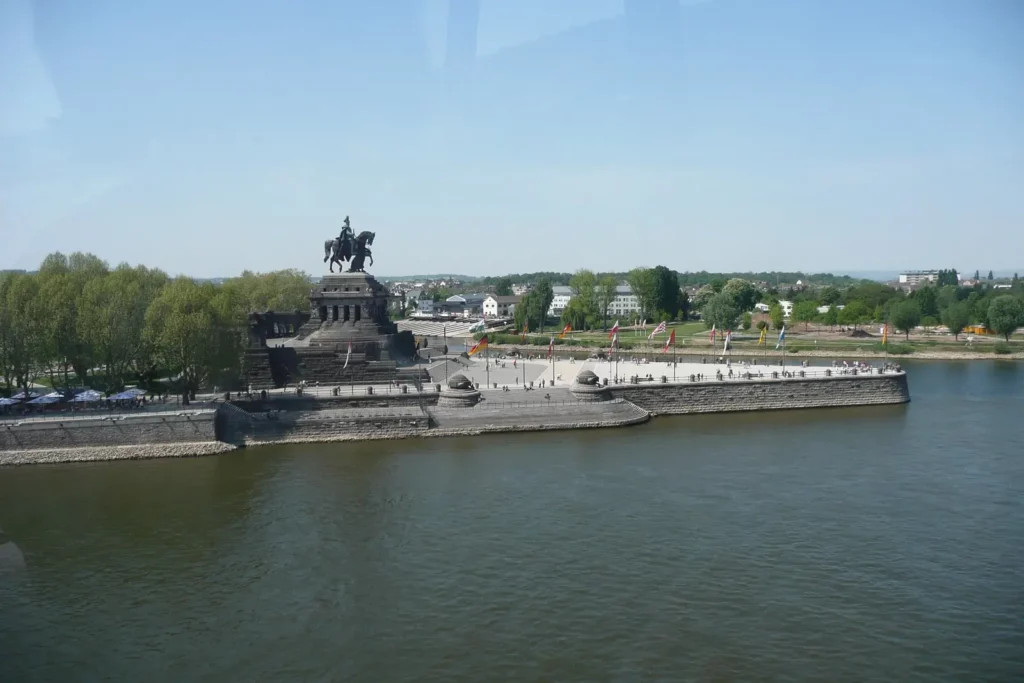
Among the main attractions:
the confluence of the rivers – so called German Corner (Deutsches Eck) with a statue of Emperor Wilhelm 1,
the Archbishop’s Palace,
the Ehrenbreitstein fortress,
the residence of the German Order (Deutschherrenhaus),
the Basilica of St. Castor (10th century),
Romanesque church of Our Lady (13th century).
The archbishop’s palace (Kurfürstliche Schloss) was built at the end of the 18th century, but the interior decoration was not completed, as the archbishop had to flee with his movable property from the French army. Afterwards, the palace was used as a barracks. Now it hosts meetings, workshops, concerts and weddings.
In 1216, the archbishop donated to the German Order part of the territory of the church of St. Castor near the German corner with the hospital (hence the name – German corner). Only a part of the buildings remained after the air raids.
Basilica of St. Castor is the oldest church in Koblenz (first half of the 9th century). The Carolingian kings met regularly at St. Castor. In the 12th century the church was reconstructed and acquired a modern look. In the 19th century Restoration was carried out and the interior was changed. During the raids, the church was damaged, but not badly on the whole.


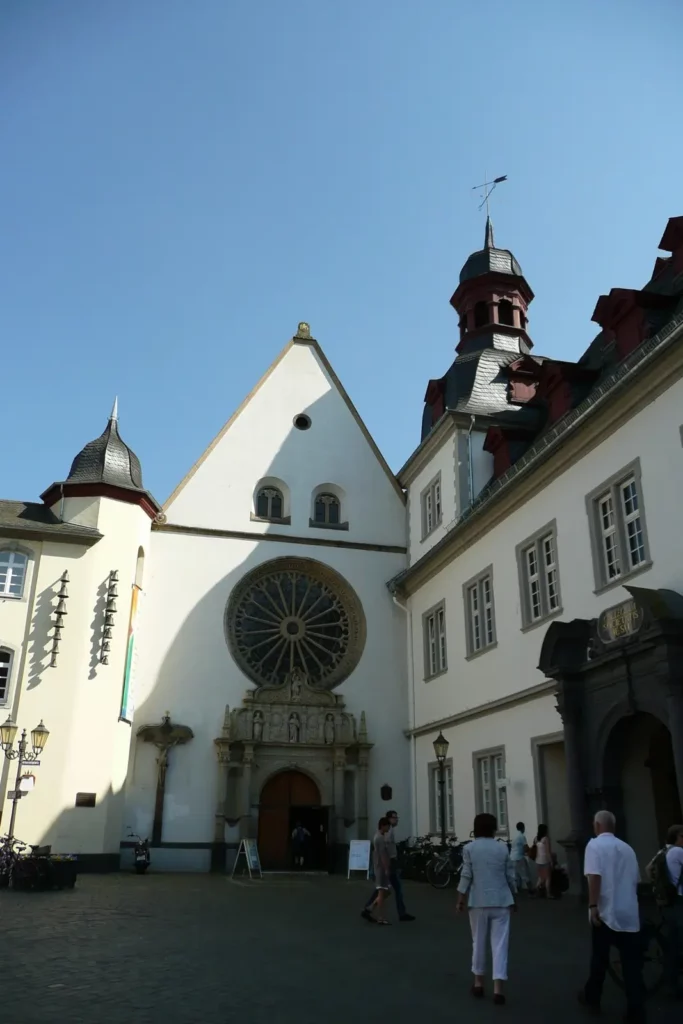
Ehrenbreitstein fortress
Ehrenbreitstein Fortress (Festung Ehrenbreitstein) has been known since the 16th century. In 1801, the French destroyed it, and later Prussia rebuilt the fortress. You can get there with the help of a new cable car from the opposite bank. Link
There is also adventure golf on the opposite bank. Link
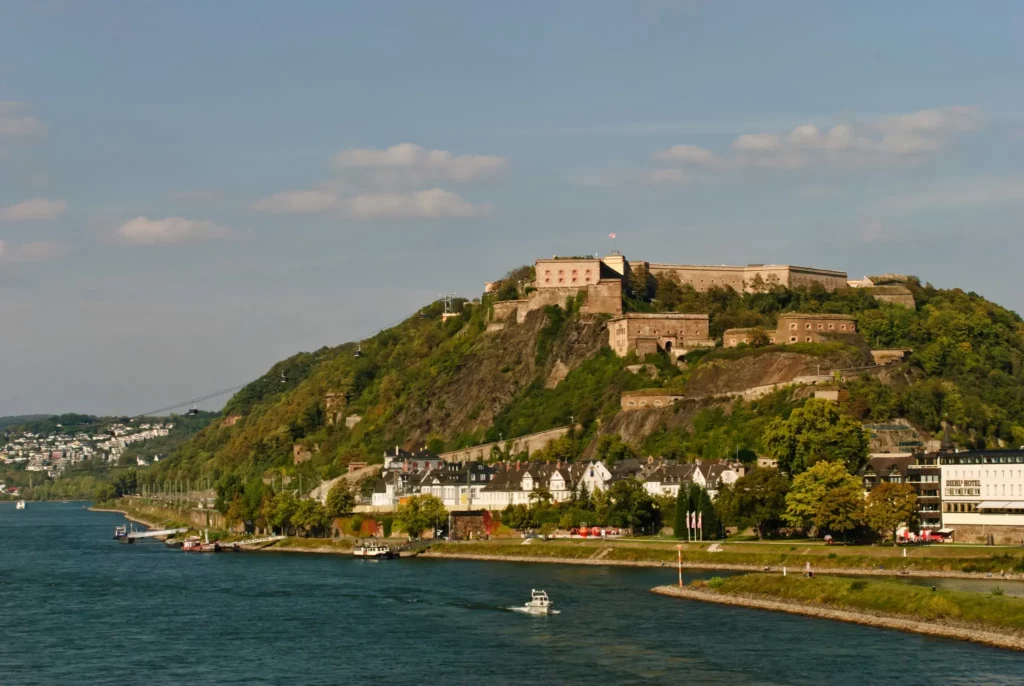
The first fortification on the site of the Ehrenbreitstein fortress dates back to 1000 BC. In 55 BC Roman troops under the command of Julius Caesar reached the Rhine and built a bridge between Koblenz and Andernach.
In the 9th century Koblenz was founded. After the division of the kingdom of the Franks in 843, Koblenz became part of Lorraine, in 925 – part of the German kingdom. In 1018, Emperor Henry II handed over the city to the Archbishop of Trier, in whose possession it remained until the 18th century. The city was repeatedly destroyed: during the Thirty Years’ War, in 1689, in 1944 and 1945.
Castles on the Middle Rhine on the map. 1. From Rüdesheim to Bacharach
Moselle: Castle Eltz, Cochem and Trier attractions
other posts about #Rhein
Do you enjoy the site without cookies? This means that I work for you at my own expense.
Perhaps you would like to support my work here.
Or change your cookie settings here. I don’t use personalized ads

